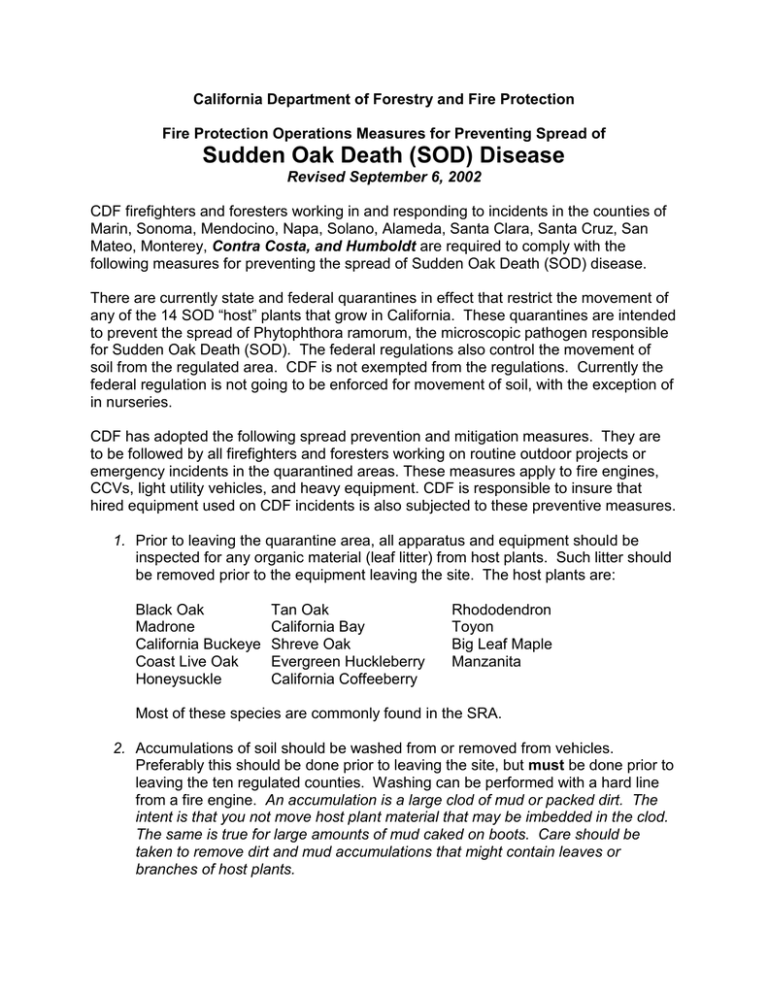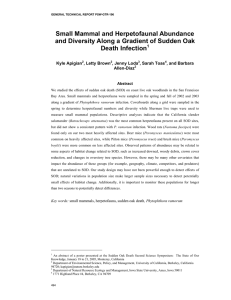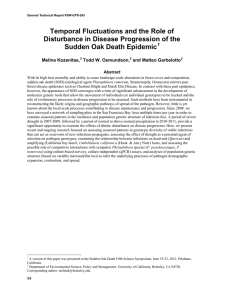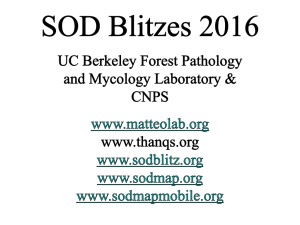California Department of Forestry and Fire Protection
advertisement

California Department of Forestry and Fire Protection Fire Protection Operations Measures for Preventing Spread of Sudden Oak Death (SOD) Disease Revised September 6, 2002 CDF firefighters and foresters working in and responding to incidents in the counties of Marin, Sonoma, Mendocino, Napa, Solano, Alameda, Santa Clara, Santa Cruz, San Mateo, Monterey, Contra Costa, and Humboldt are required to comply with the following measures for preventing the spread of Sudden Oak Death (SOD) disease. There are currently state and federal quarantines in effect that restrict the movement of any of the 14 SOD “host” plants that grow in California. These quarantines are intended to prevent the spread of Phytophthora ramorum, the microscopic pathogen responsible for Sudden Oak Death (SOD). The federal regulations also control the movement of soil from the regulated area. CDF is not exempted from the regulations. Currently the federal regulation is not going to be enforced for movement of soil, with the exception of in nurseries. CDF has adopted the following spread prevention and mitigation measures. They are to be followed by all firefighters and foresters working on routine outdoor projects or emergency incidents in the quarantined areas. These measures apply to fire engines, CCVs, light utility vehicles, and heavy equipment. CDF is responsible to insure that hired equipment used on CDF incidents is also subjected to these preventive measures. 1. Prior to leaving the quarantine area, all apparatus and equipment should be inspected for any organic material (leaf litter) from host plants. Such litter should be removed prior to the equipment leaving the site. The host plants are: Black Oak Madrone California Buckeye Coast Live Oak Honeysuckle Tan Oak California Bay Shreve Oak Evergreen Huckleberry California Coffeeberry Rhododendron Toyon Big Leaf Maple Manzanita Most of these species are commonly found in the SRA. 2. Accumulations of soil should be washed from or removed from vehicles. Preferably this should be done prior to leaving the site, but must be done prior to leaving the ten regulated counties. Washing can be performed with a hard line from a fire engine. An accumulation is a large clod of mud or packed dirt. The intent is that you not move host plant material that may be imbedded in the clod. The same is true for large amounts of mud caked on boots. Care should be taken to remove dirt and mud accumulations that might contain leaves or branches of host plants. 3. All cutting and scraping tools, including chainsaws, used for cutting or scraping around potential host plants should be sprayed with either Lysol® or a mixture of water and bleach to disinfect the cutting surface. Any wood chips and organic matter should also be removed from the chainsaw. During fire season, saws should be disinfected at the end of each day in anticipation of an out-of-county dispatch prior to the next day’s project work. 4. On major incidents where a Demob vehicle mechanical inspection is set up, these mitigations should be part of the inspection process, and the preventive measures described above should be implemented as long as the SOD regulations are in effect. 5. The only allowable exception to the procedures described above is when resources are dispatched to an emergency incident as initial attack resources when they have not had time to properly clean the vehicle following possible exposure to SOD host plants. In that instance the procedures should be implemented at the earliest possible time. These procedures will remain in effect for as long as the SOD regulations are in effect. It is recommended that the county Agricultural Commissioner of quarantined counties and of counties adjacent to the quarantined counties be notified of these procedures and of CDF’s policies regarding enforcement of SOD regulations.





